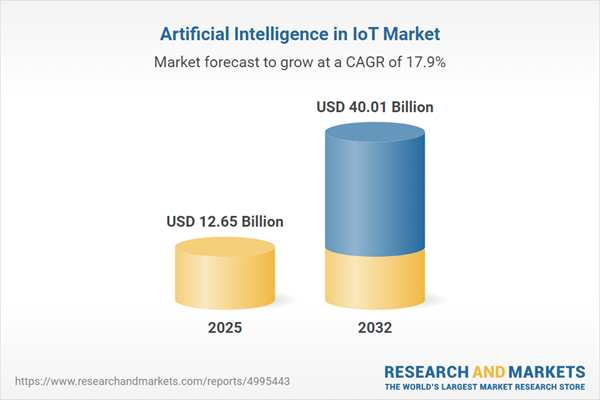Speak directly to the analyst to clarify any post sales queries you may have.
The Artificial Intelligence in IoT market is redefining global connected systems as advanced analytics and machine learning capabilities become embedded across devices, networks, and services. Senior leaders are actively exploring how intelligent IoT can unlock operational efficiencies, data-driven insights, and new business models in a dynamic, competitive landscape.
Market Snapshot: Growth and Competitive Evolution in Artificial Intelligence in IoT
The Artificial Intelligence in IoT Market grew from USD 10.75 billion in 2024 to USD 12.65 billion in 2025. It is expected to continue growing at a CAGR of 17.85%, reaching USD 40.01 billion by 2032. This rapid trajectory reflects how enterprises are increasingly integrating AI algorithms into IoT frameworks, allowing real-time decision-making, automation, and predictive analytics across critical operational environments. Diversified investments are driving agility within industries grappling with complex data and the need for scalable intelligence.
Scope & Segmentation: Comprehensive Coverage of the AI in IoT Ecosystem
- Applications: Agriculture, Connected Car, Healthcare, Retail, Smart Grid, Smart Home, Smart Manufacturing (Asset Tracking, Predictive Maintenance, Process Optimization, Quality Management), Transportation
- Industry Verticals: Agriculture, Automotive, Energy & Utilities, Healthcare, Manufacturing (Automotive Manufacturing, Discrete Manufacturing, Process Manufacturing), Retail, Smart Cities, Transportation & Logistics
- Component Types: Connectivity Modules (Bluetooth, Cellular, LPWAN: LoRaWAN, NB-IoT, Sigfox, Satellite, Wi-Fi), Edge Devices, Platforms, Sensors (Motion, Optical, Pressure, Temperature), Services, Software
- Connectivity Technologies: Bluetooth, Cellular, Ethernet, LPWAN (LoRaWAN, NB-IoT, Sigfox), Satellite, Wi-Fi
- Deployment Models: Cloud (Community Cloud, Private Cloud, Public Cloud), Hybrid (Edge Hybrid, Multi-Cloud Hybrid), On-Premises
- Geographic Regions: Americas (United States, Canada, Mexico, Brazil, Argentina, Chile, Colombia, Peru), Europe, Middle East & Africa (United Kingdom, Germany, France, Russia, Italy, Spain, Netherlands, Sweden, Poland, Switzerland, United Arab Emirates, Saudi Arabia, Qatar, Turkey, Israel, South Africa, Nigeria, Egypt, Kenya), Asia-Pacific (China, India, Japan, Australia, South Korea, Indonesia, Thailand, Malaysia, Singapore, Taiwan)
- Companies Profiled: Amazon.com, Microsoft Corporation, Alphabet Inc., International Business Machines Corporation, Cisco Systems, Intel Corporation, Huawei Technologies, Siemens Aktiengesellschaft, NVIDIA Corporation, Hitachi Ltd.
Key Takeaways: Strategic Priorities in the Artificial Intelligence in IoT Market
- AI integration into IoT solutions accelerates the transition from siloed pilot projects to scalable enterprise deployments, enabling organizations to leverage data insights for continuous optimization.
- Enterprises are embedding advanced machine learning at the edge, supporting latency-critical use cases like industrial automation, connected vehicles, and real-time asset monitoring.
- Data-driven strategies, powered by contextual analytics and anomaly detection tools, are expanding operational agility well beyond traditional alert systems or manual diagnostics.
- Security is evolving from perimeter defense to intelligence-driven, adaptive protection frameworks, as machine learning helps proactively detect risks and automate incident response across distributed networks.
- Industry collaboration and ecosystem partnerships, including alliances between technology providers and OEMs, foster standardization and scalable AI deployment, lowering integration complexity for enterprises.
Tariff Impact: Shaping Global Supply and Innovation
Recent United States trade policies have introduced additional tariffs on key components like semiconductors and connectivity modules, impacting procurement strategies and total cost structures for global IoT deployments. Organizations are adapting by realigning workload distribution between cloud, edge, and hybrid infrastructure to manage budget constraints and performance requirements. In response, there is growing investment in domestic supply chains and localized manufacturing, helping service providers build resilience while addressing national technology priorities.
Methodology & Data Sources
This report leverages a multi-phase research approach, including primary interviews with domain experts as well as secondary analysis from industry publications, association data, and technology white papers. Robust triangulation and cross-referencing with vendor and end user case studies ensure the accuracy and reliability of all insights provided.
Why This Report Matters: Decision Support for Senior Leaders
- Gain precise, fact-based intelligence on the evolving landscape, regional dynamics, and key players shaping the Artificial Intelligence in IoT market.
- Identify growth opportunities and reduction strategies for risk or tariff impacts, supporting strategic investment and supply chain resilience.
- Unlock actionable insights for adopting scalable, intelligent IoT solutions tailored to your organization’s sector and operational objectives.
Conclusion
Artificial intelligence is transforming the IoT value chain by embedding intelligence at every layer, empowering enterprises to optimize operations and remain competitive. Adapting strategy for this convergence is essential to achieving future-ready digital transformation and sustainable value creation.
Additional Product Information:
- Purchase of this report includes 1 year online access with quarterly updates.
- This report can be updated on request. Please contact our Customer Experience team using the Ask a Question widget on our website.
Table of Contents
3. Executive Summary
4. Market Overview
7. Cumulative Impact of Artificial Intelligence 2025
Companies Mentioned
The companies profiled in this Artificial Intelligence in IoT market report include:- Amazon.com, Inc.
- Microsoft Corporation
- Alphabet Inc.
- International Business Machines Corporation
- Cisco Systems, Inc.
- Intel Corporation
- Huawei Technologies Co., Ltd.
- Siemens Aktiengesellschaft
- NVIDIA Corporation
- Hitachi, Ltd.
Table Information
| Report Attribute | Details |
|---|---|
| No. of Pages | 191 |
| Published | November 2025 |
| Forecast Period | 2025 - 2032 |
| Estimated Market Value ( USD | $ 12.65 Billion |
| Forecasted Market Value ( USD | $ 40.01 Billion |
| Compound Annual Growth Rate | 17.8% |
| Regions Covered | Global |
| No. of Companies Mentioned | 11 |









